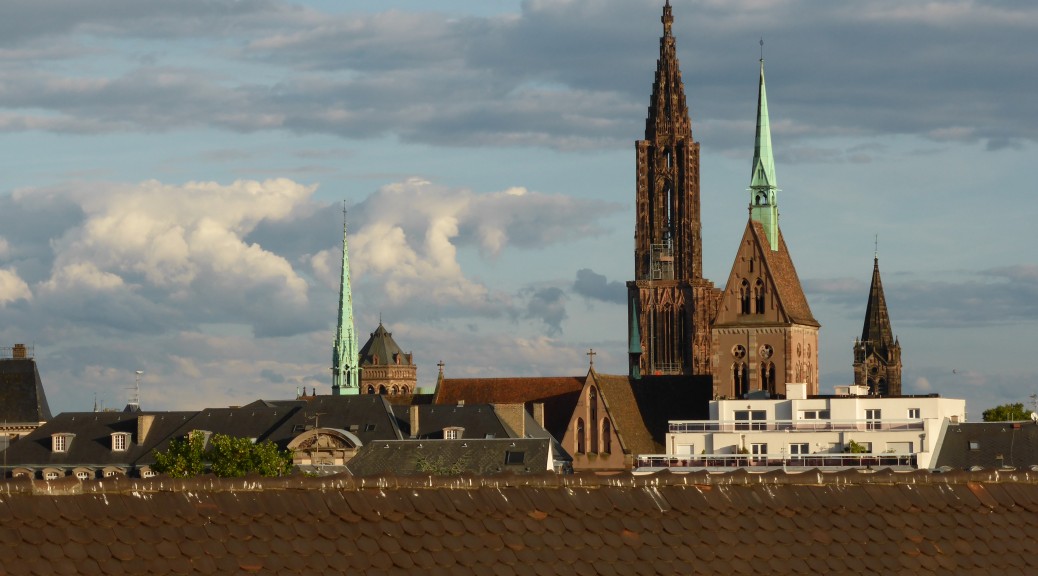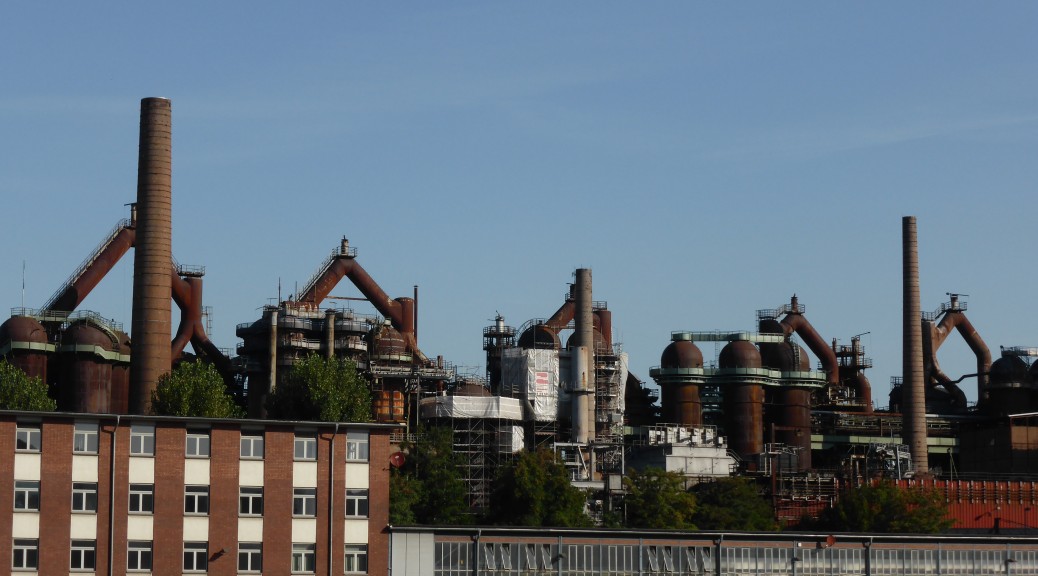[Content Advisory: Here follows a gratuitous amount of industrial history, associated photos and general talk of ironmaking. If that doesn’t interest you, too bad – it was the highlight of the trip so far. Yes, I know that that is quite sad.]
When I chose my camping spot for the night, I did not realise there was a chiming church clock just the other side of the river. Or a building site. Still, I slept well enough and had a pretty good gauge of the time each time I awoke. Eager to see it, or with nothing better to do, I was first through the gates at Volklingen Iron Works. I was quite nervous about leaving my bike unattended for so long with only a lock that serves only to thwart the opportunist thief. But the attendant assured me that it was quite safe, I suppose you don’t get a lot of thieves frequenting industrial museums early in the day. By the time I returned three hours later, there were many more bikes around – so mine was less conspicuous.
When they shut the plant (six blast furnaces and much more ancillary equipment) down in 1986, they really did just leave it. I couldn’t believe how much there is to see – I was fascinated and even though the multimedia presentation wasn’t in English, all the signs were, so it was easy enough to understand. You could wander around an awful lot without barriers getting in the way – obviously some areas are off limits as the platforms and walkways have decayed over time, but work continues. Donning a hardhat, you could even climb through forty-five metres of height up stairs (brought back a lot of memories of getting around the NZS Iron Plant) to the charging floor and then go even higher and get amongst the off-gas system.
The explanation of the process was very well done, and only later on in a hall under the burden room did you get to read/hear a few stories of what it was like to work there. I would have liked to have seen more of that – at one stage in the sixties, some 16000 people were employed making iron. Incredible to think; although each blast furnace only had the daily capacity of one NZS Melter (of which there are two). Well, obviously I loved my visit there – as shown by the fact I took so many photos. I will let some of them tell the rest of the story.





Hoist controls in the inclined ore conveyor machine room.

I’d noticed these two hills the night before – completely different to any others in the region. I should have known that they are slag heaps from almost one hundred years of operation.

Charging floor – the cars on the monorail used for feeding the furnaces.

Top of the inclined conveyor.

Off-gas system, part of.

Still an industrial town

More off-gas system.

The hood that is raised to charge five cars at a time into the furnace – there is another such bell cover further down to prevent the furnace gases escaping.



Nature taking hold at height.

Work continues all around the site still – I was surprised by how much exactly. All to broaden the areas accessible to visitors.

Metal tap hole

Mud gun – used for closing taphole

Slag taphole

Coke ovens – coke side



Coke ovens – machine side

Inclined ore conveyor, built in the 1910s – took the sintered iron ore up to the charging level. The main reason the plant could not be expanded to compete in the 1980s by making the furnaces larger (taller) is that this conveyor could not be heightened.


The charge cars used on the monorail system.
After all that excitement, the time available for riding was cut back substantially. It was a very easy eighty-odd kilometres. Mostly following the Saar upriver, stopping at a bakery in France somewhere before following the Blies upstream back into Germany. This turned into an old rail trail, sealed as they mostly are, so was rather quick – well, for my bike. There were many people out riding beside the river all afternoon. Which would be why there were multitudes of beer gardens backing on to the cycle routes. I stopped in at one for a drink and what turned out to be a strange rectangular pizza-like dish – very white & runny cheese, much onion and pancetta.

The signs I’ve been following for three days.


A glorious evening to be out riding – sun setting on fields just cut for haymaking
Tomorrow, I should make the town where the TransVosges MTB route starts – it’s only fifty kilometres as the crow flies, but after my northern Luxembourg experience that could be quite hard work, although it’s not as hilly around here. I’ve enjoyed the last two days’ riding with no rain and occasional warmth; a bit of rain has fallen at night, so my tent is wet again – but, hey-ho. Hopefully the TransVosges has had a chance to dry out – I’ll shall have to see if it’s suitable for me.

 What houses are looking like now, opportunely taken while putting more layers on for the evening riding.
What houses are looking like now, opportunely taken while putting more layers on for the evening riding.




 I did enjoy looking at all the steep roofs from the cathedral tower.
I did enjoy looking at all the steep roofs from the cathedral tower.








 The view from Adrien’s apartment
The view from Adrien’s apartment


 Mention must be made of firewood stacks – they’re everywhere out here and some of them really are quite large.
Mention must be made of firewood stacks – they’re everywhere out here and some of them really are quite large.

































